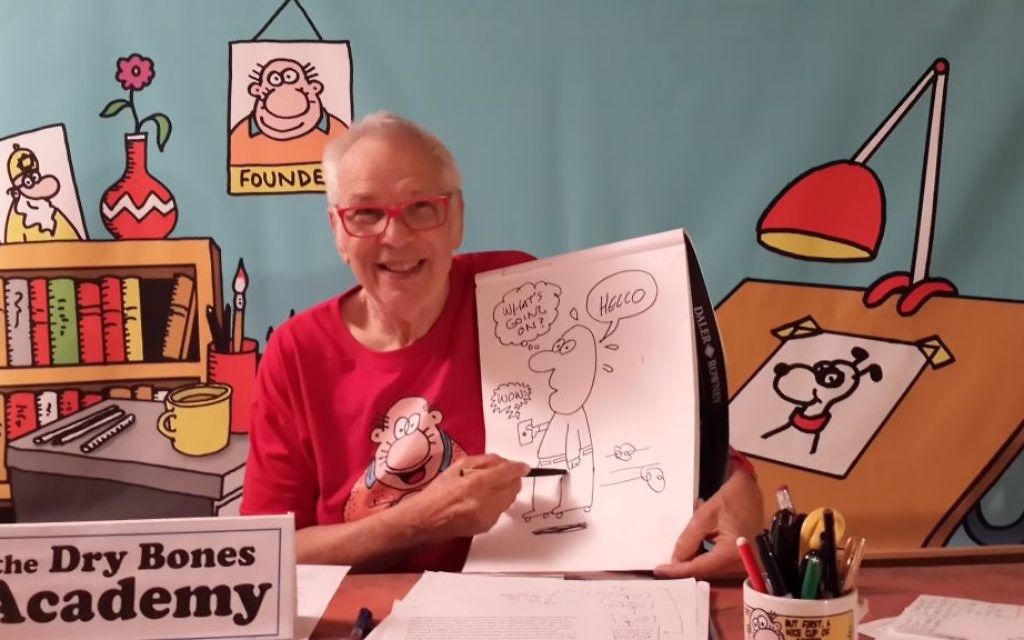Cartoon Haggadah Tells Serious Story of Survival
"Dry Bones" creator Yaakov Kirschen sees the Passover seder book as the key to Jewish continuity.
We are all in the debt of Koren Press, which decided to publish a new edition of “The Dry Bones Passover Haggadah” last year.
I very much like to look at haggadot, but I have never attempted to collect them. However, I have seen quite a number, and I have found that some make a bigger impression on me than others.
I have known “Dry Bones” creator Yaakov Kirschen for about 30 years. He drew a cartoon for our youngest son’s bar mitzvah, for our 25th anniversary, and for the 50th anniversary of my parents, Louis and Anna of beloved memory.
Get The AJT Newsletter by email and never miss our top stories Free Sign Up
I have always found him to be a fascinating individual. His making aliyah was a gift to the entire Jewish people because it cemented his dream to be a cartoonist. For 45 years, he has drawn “Dry Bones,” which began in The Jerusalem Post and can be read throughout the world, including the AJT.
In the introduction to his haggadah, Kirschen describes a few of the characters in his cartoons. “The main ‘Dry Bones’ character is the kindly, idealistic ‘Uncle Shuldig.’ He represents me. His dog ‘Doobie’ projects a more objective, critical point of view.”
The author also notes that “the ‘LSW’ (his wife, Sali) claims that the loyal but doubting dog represents her.”
In his candor, Kirschen decided that he not only wants to talk to people today through his cartoons, but also wants to connect in a way that will help them focus on tomorrow.
Kirschen feels that the time for this to happen is the Passover seder. The whole family sits together, and the words of the haggadah can slip into their minds.
“My haggadah,” he said, “begins with Shuldig explaining the seder to Doobie.”
Shuldig stands there, pointer in hand, with a drawing of the seder plate on the wall. Doobie has to see to believe, which Shuldig knows well. He first explains the seder plate and its six symbolic foods, then the 15 steps of the seder. Doobie is ready, as are all of us sitting around the table.
Once the seder begins with the Kiddush, a cartoon appears with two ancient Jews leaving Egypt. “No bread?! We’ve been slaves in Egypt for 400 years. And we leave in such a hurry that … there’s ‘no time’ to pack some sandwiches?”
The punch line in this four-box cartoon: “I tell you,” one of the freed men says, “people will be talking about this for years.”
The excitement of this haggadah is found in the drawings, the cartoons and the carefully executed design by S. Kim Glassman of Jerusalem. Plus, Sali Ariel’s “hand has been involved in the look and feel of every page.”
It can be difficult to get people to listen to the story of the Exodus; “Dry Bones” has an answer. A little boy says, “When you’re a kid, you don’t have time to listen.” A suave, successful gentleman says, “And then before you know it …” — setting up the words of a budding senior citizen: “You’re the generation that they don’t have time to listen.”

Shuldig puts it all together: “This is called the miracle of Jewish continuity.”
Another haggadah cartoon shows Pharaoh on his throne saying, “We’ve got to wipe out these Israelites.” His first idea: “Let’s force them to kill all their newborn babies!” His second: “Nah! Make them drown only their boy babies — after all, I’m not a bad guy.”
On Pages 36 and 66, the Jews are building in Egypt and are being whipped so they can never stop. But then the sea splits, and our ancestors are free.
Next to the ceremony of “the cup of Elijah,” a cartoon has a yellow background so the character of Moses with a white beard stands out on Mount Sinai. Moses questions G-d, “Israel will become a light unto the nations?” The answer is “YES.”
Then G-d continues, “But ‘the nations’ will get really good at looking the other way.” Moses says, “Bummer!” G-d answers, “YUP.”
The return to Eretz Yisrael is presented in modern terms. On one page the cars and buses are seen driving up to Jerusalem. On the page opposite the buses and cars are passing through greenery as they move toward the fancy city of Tel Aviv.
Accompanying L’shana habaa b’Yerushalayim, we see the beautiful greenery through which the vehicles pass as Jerusalem awaits them.
The idea of using the haggadah to deepen people’s awareness of the Exodus, even for the future, is interesting because it was first used for actual commercial products. In my “American Heritage Haggadah,” I brought to light companies from banks to coffee companies (Maxwell House) to wines and other foodstuffs that realized that the “hang time” for reading the haggadah and looking at its text and ads is quite lengthy.
A hundred years after the first haggadah with commercial ads, “Dry Bones” draws us in via his fascinating and jubilant text. He does not expect us to buy material goods, food or wine, but to take a bite into the cartoons and illustrations so that we can make the haggadah’s message our own.
“Everyone knows that the Jews have survived as a people,” Kirschen said, but, in his view, no one knows why. “They think we have a secret book, and we do, but its identity is more obvious than most people would think.”
Sitting in his studio in Herzliya Pituach, he added: “The secret book of the Jews is the Passover haggadah. We have a guidebook for a ceremony that will be in our own home every year to teach the next generation.”
The Dry Bones Passover Haggadah
By Yaakov Kirschen
Menorah Books, 104 pages, $16.95
www.korenpub.com/maggid_en_usd/the-dry-bones-passover-haggada.html





comments